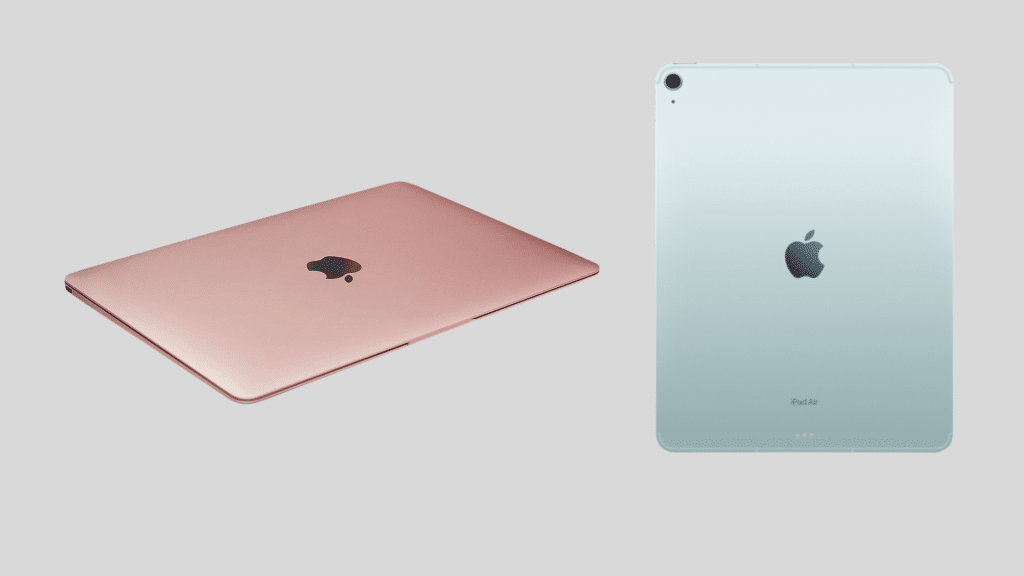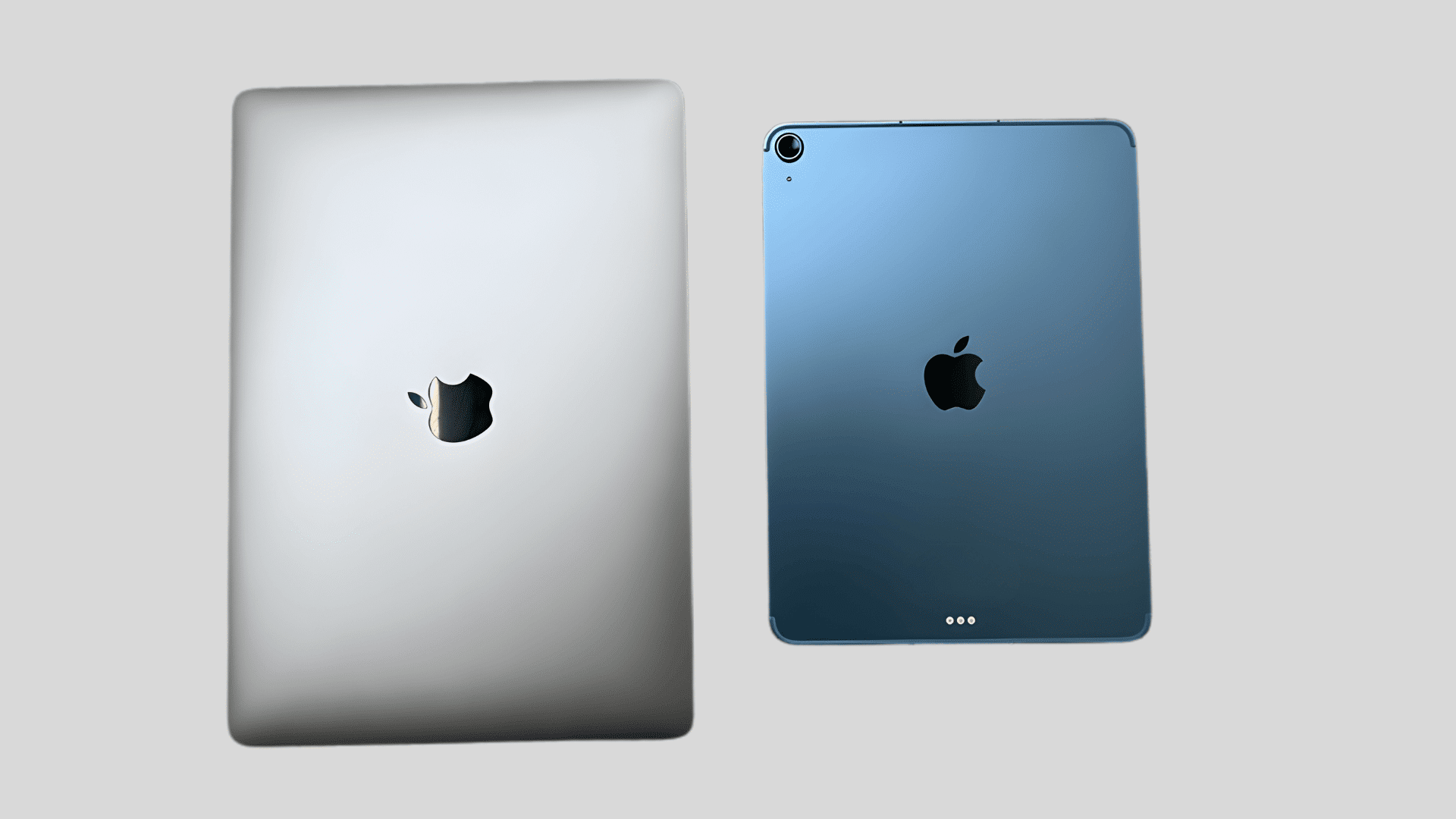Choosing between a macBook and an iPad isn’t always easy. Both now share Apple’s powerful M-series chips and deliver smooth, fast performance, but they’re built for very different ways of working.
The MacBook focuses on multitasking, file management, and professional software, while the iPad offers a hands-on, mobile experience that’s perfect for creativity and flexibility.
This guide explains how they differ in performance, usability, and value, helping you see which one fits your daily routine best.
Whether you need a device for study, design, travel, or full-time work, this comparison will show the strengths and limits of each option.
Overview of MacBook and iPad
Apple’s MacBook and iPad now share the same M-series chips, but they serve different kinds of users.
The MacBook is built for those who need a full desktop experience, multitasking, file management, and pro-grade apps. The iPad, on the other hand, focuses on flexibility, touch interaction, and creativity.
If you value power, software freedom, and traditional workflow control, the MacBook feels more complete.
But if portability, sketching, and mobility matter more, the iPad delivers a lighter, more adaptable experience that still packs impressive performance.
Both shine in their own spaces; your choice comes down to how and where you like to work.
Key Differences: iPad Vs. MacBook
Choosing between the iPad Pro and MacBook Pro can be tricky. Both are powered by Apple’s M-series chips and deliver incredible performance, but they’re designed for different workflows.
1. Operating System
The MacBook runs macOS, a desktop operating system designed for multitasking, file control, and pro-level software. It’s ideal if you rely on full desktop apps and want smooth window management.
The iPad, powered by iPadOS, focuses on touch use and mobile-style apps, making it more intuitive for quick tasks and creative work on the go.
2. Performance
MacBooks handle demanding workloads like coding, 4K editing, and multitasking without slowing down, thanks to stronger cooling and higher RAM options.
The iPad Pro performs impressively for light to medium tasks like drawing, browsing, and note-taking. It’s quick and efficient, but may struggle with long or complex workflows compared to a MacBook.
3. Display
MacBooks feature larger, high-resolution screens suited for editing, writing, and managing multiple windows simultaneously. They offer consistent brightness and color accuracy for design or video work.
The iPad Pro’s touch display, on the other hand, shines for sketching, streaming, or reading it’s more interactive and perfect for hands-on creative use.
4. Input
MacBooks come with a built-in keyboard and trackpad, giving precise control and comfort for long typing sessions.
The iPad Pro supports touch, the Apple Pencil, and optional accessories like the Magic Keyboard. This flexibility is great for designers or travelers who switch between typing, sketching, and navigating with gestures.
5. Portability
The MacBook is slim and lightweight, but feels more comfortable on a desk or lap. It’s a productivity powerhouse that still travels easily.
The iPad Pro is even lighter and easier to hold, perfect for reading, sketching, or working on the go. It’s ideal for students, commuters, or mobile professionals who value flexibility.
6. Battery Life
MacBooks typically last 12–18 hours, depending on the model and tasks, offering reliable all-day use.
The iPad Pro usually runs 10–12 hours, which is strong for its size.
While the MacBook holds an advantage during intensive work, the iPad’s efficiency makes it great for portable, everyday use without worrying about frequent charging.
7. Versatility
The MacBook excels at long work sessions with professional-grade software and multitasking features. It’s perfect for focused, complex projects.
The iPad, however, adapts between tablet and mini-laptop modes with ease. It’s a flexible option for creatives and hybrid users who want both portability and power in one sleek device.
Operating System, Performance, and Workflow Experience

From operating systems to multitasking and input methods, each device creates a unique workflow that appeals to different kinds of users
Operating System and Software Ecosystem
The MacBook runs macOS, a full desktop system built for multitasking and professional software. It lets you open multiple apps, manage files freely, and handle heavy tasks like coding or video editing with ease.
The iPad uses iPadOS, designed for touch and mobility. It’s fast, simple, and great for note-taking, sketching, and light productivity.
With features like Stage Manager, external display support, and iCloud syncing, it’s more capable than before but still limited for complex workflows compared to macOS.
Performance and Hardware
Both devices use Apple’s powerful M-series chips, but the macBook delivers stronger sustained performance thanks to better cooling and higher RAM capacity.
It handles demanding work like coding, 3D design, and video editing smoothly. The iPad, though fast and efficient, performs best for lighter creative tasks or short bursts of productivity while staying silent and portable.
Input and Workflow Experience
The macBook offers a built-in keyboard and large trackpad, making it ideal for fast, accurate typing and multitasking.
The iPad relies on touch controls, Apple Pencil, and optional keyboards for creative or mobile use. It’s perfect for sketching, marking documents, or browsing, while the MacBook remains better suited for detailed, precision-focused workflows.
Cost Comparison: MacBook vs iPad
Apple’s latest MacBooks and iPads both deliver premium performance but cater to different types of users.
| Model | Configuration | Approx. Price Range (USD) | Notes |
|---|---|---|---|
| MacBook Air (M-series) | 8GB RAM, 256–512GB Storage | $430–$1,499 | Includes keyboard, trackpad, and macOS. |
| MacBook Pro (14-inch) | 16GB RAM, 512GB–2TB Storage | $1,600–$3,000+ | High-end option with more power and ports. |
| iPad Pro (M4) | 256GB–1TB Storage | $999–$2,000+ | Add-on costs for Magic Keyboard and Pencil. |
Even though the iPad Pro offers incredible flexibility, its full setup with accessories can cost as much as a base MacBook Pro. The MacBook remains a ready-to-use device for work, while the iPad is ideal for creative, on-the-go users.
Use-Case Breakdown
Each device fits a different kind of user depending on how and where it’s used. Here’s how the MacBook and iPad perform in everyday scenarios.
MacBook: For Power and Productivity
The MacBook is designed for users who need dependable performance and a full desktop experience. It’s built to handle heavy workloads while staying smooth and efficient across long sessions.
- Reliable Performance: Handles coding, editing, multitasking, and file management without lag.
- For Students: Ideal for writing essays, organizing research, and creating presentations.
- For Professionals: Runs pro software for design, spreadsheets, and data-heavy tasks.
- For Travelers: Offers a balanced mix of speed, display quality, and long battery life.
- Best Fit: Perfect for anyone who values stability, comfort, and consistent performance in everyday work.
iPad: For Flexibility and Creativity
The iPad focuses on mobility, creativity, and ease of use. It’s built for users who prefer a hands-on, touch-based experience for both work and play.
- Highly Portable: Lightweight and easy to carry for work, travel, or daily use.
- Creative Tools: Works seamlessly with Apple Pencil for drawing, sketching, and designing.
- For Students: Great for note-taking, reading, and quick research on the go.
- For Creators: Ideal for Procreate, LumaFusion, and photo editing projects.
- Everyday Use:Perfect for browsing, streaming, and casual productivity with a fun, responsive interface.
These features make the iPad a strong choice for users who value creativity, portability, and versatility in one device. It’s ideal for those who prefer working anywhere without being tied to a traditional desktop setup.
The Hybrid Approach
Some people don’t choose between a MacBook and an iPad; they use both. Together, they create a flexible setup that blends power, mobility, and creativity.
Sidecar lets you turn your iPad into a second screen for your MacBook. It’s great for editing, drawing, or keeping notes open while you work on something else. This feature helps when you need more space without carrying a monitor.
Universal Control allows you to use one keyboard and trackpad across both devices. You can move your cursor from the MacBook to the iPad smoothly and drag files between them. It feels like using one connected system.
AirDrop and Handoff make sharing easy. You can start an email or design on one device and continue it on the other. Photos, files, and links transfer instantly without cables or cloud uploads.
Using both devices together gives you the best of both worlds. You get the MacBook’s strength for demanding work and the iPad’s freedom for drawing, note-taking, or travel.
Personal Experiences & Reddit Voices
Users often highlight the practical differences between using a MacBook and an iPad. Their firsthand experiences reveal how each device fits into daily life – what works well, what doesn’t, and where each one truly shines.
“iPad is only a companion device. Most of my school is done on my laptop, but my iPad acts as my design work/notes/textbook reader. Anything, even making slideshows or Excel just kinda sucks on the iPad compared to literally any other computer.” – u/Nocphobious
“I can’t imagine having a Mac and an iPad and thinking the best productivity experience is anything other than sidecar-ing the iPad to the Mac.” – u/CreativeDog2024
“My iPad Pro is my travel buddy. It handles writing, sketching, and entertainment easily. But when it comes to big projects or heavy editing, I always go back to my MacBook.” – u/TechNomad90
“The MacBook still wins for multitasking. I use the iPad for notes and illustrations, but switching between multiple apps on it can be clunky compared to macOS.” – u/PixelPilo
Conclusion
When it comes to the macBook vs iPad, the right choice depends on how you actually work, not just what looks good on paper.
The MacBook gives you power, multitasking, and the comfort of a full desktop setup. The iPad focuses on flexibility, creativity, and portability, perfect for quick, hands-on tasks anywhere.
Think about what matters most: long work sessions or easy mobility. Both are excellent, just built for different lifestyles.
Want more detailed comparisons and buying tips? Check out my latest tech guides to find the perfect Apple device for your daily needs.








